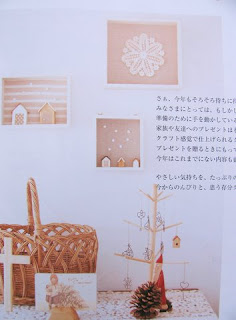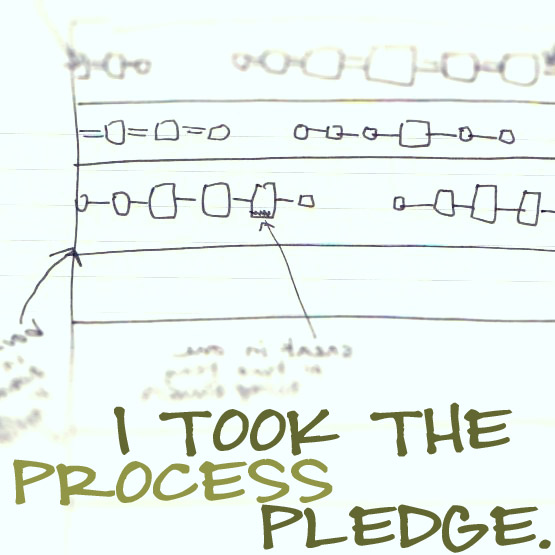I had begun quilting years ago, just before my first baby arrived. She was a lovely baby, but a baby who never, never slept. And even once she finally did, at age three, I found that pins and all the intriguing things you use while sewing are not compatible with small children. On top of that, we did not for many years have the sort of house that would support the reality of A Sewing Room. But finally, I arrived at a place in my life and my real estate portfolio, where I could have both time and space for this oddly compelling activity, which is creative but not too creative, and demanding but not too demanding. And with retirement beginning to loom toward me out of the mists of time, it struck me that quilting and
zakka type sewing would be a wonderful activity to carry into old age...particularly that part of old age in which I would have limited mobility. I had watched some of my elders, thanks to modern medicine the first generation to reliably expect an extended old age, experience that old age without any kind of roadmap. Their own parents rarely survived into their late '70's, and their only experience of aging, it turned out, was of much younger people. I watched, sad and helpless, as they tried to hammer their 80 year old selves into a template more suited to 50 year olds. It was not a happy experience. That futile effort not only shortened their lives, it degraded the quality of the life they had.
This, I promised myself, would never happen to me.
So part of anticipating my likely long, but increasingly less physically robust old age, was setting the stage with interests and skills that would serve me once hiking, diving and traveling were no longer easy endeavours. I knew there was a whole, wonderful life available to me, even if I tired easily or were confined to my chair. And I very much wanted to make my declining years pleasant for me and less anxiety ridden for my own children.
The first thing I realized, as I waved my eldest off to university, was that my dear old sewing machine, circa 1975 Sears catalogue, was at the end of its always cranky lifetime. Sewing machines had, in my absence, become computerized. And they could do fabulous things, like embroider. So I began visiting sewing stores. And what a shock that was!
I confess I did not demo very many machines before I bought my first truly good machine, in part because my Home Ec auntie decreed that Husqvarna was the ONLY way to go, and in part because my exhaustive online research turned up uniformly glowing reviews for Husqvarnas-Viking (HQV) machines. The HQV website was very much better than most and their customer service department responded rapidly, intelligently, and sympathetically to my questions.
But I was sadly handicapped when I went out to actually look at machines. I was entirely unprepared for the pernicious dealer system that is, unhappily, the signature feature of the sewing industry. The larger manufacturers demand that dealers only sell to those customers who reside in their sales area. Which is all very well if your local dealer is top notch, and hires top notch staff, and if you never move, and if you actually HAVE a local dealer: if you live outside a large metropolitan centre, all bets are off. To ensure that you, the customer, cooperate with the dealer system, your warranty is only valid at the dealer you originally purchased from, and the much vaunted lesson and "support" packages are only valid from your purchase point as well. Too bad if you move, or your dealer retires or goes out of business. The warranty and support
are not transferable. They are not attached to your machine or you; they are attached to your purchase dealer. And to further force you to fall in step with this system, the manufacturers and dealers will not advertise prices (a mainstay tactic in all price fixing systems), and will not quote over the phone, email, or postal service.
Since when is the price of consumer goods a state secret???
I can only conclude that this archaic "hog tie you to a dealer" system, which even the automobile industry abandoned long, long ago, is a direct reflection of the fact that the sewing machine industry has written off their typical customers (women) as stupid, easily manipulated persons with zero access to discretionary purchasing decisions, and zero ability to outwit the corrupt dealer system.
So when I walked into my local dealer, I made every rookie mistake.
First, I chose the dealership (there were 3 within an hour of my home) that was most highly rated by the HQV website. I did not realize that they were considered best on the basis of sales volume...which set me up for a high pressure sales experience. At the time, I was not only unprepared for a high pressure sales pitch, I was inexperienced and darned uncomfortable with them too.
My first experience in the shop was sticker shock. Prepare yourself ladies, because as shocked as I was then by the price of new sewing machines, they have tripled in price since. At the time I went in to check things out, I expected to pay around $700 for a really nice machine. How wrong I was. The top of the line (TOL) machine at that time was around $6000. It sewed beautifully. It had auto functions, a computer screen in the front, stored hundreds of specialty stitches, boasted an auto threader....and it
embroidered. Well, not quite. It embroidered no more than the few designs they gifted you on a floppy disk UNLESS you purchased approximately $2500 worth of proprietary software. Then you could embroider all kinds of stuff. But only HQV designs. Which cost about $125 a disk...on average $10 per design, roughly.
Happily for me, I was at least computer savvy, unlike HQV's target demographic (which I regret to say was retired, elderly ladies with husbands who controlled the family budget...note that the sewing machine industry has still to accept that this may not be their target demographic at all). No way was I
ever going to buy proprietary software of any stripe! Open source code was already a hallmark of the computer world, and that would certainly mean "inexpensive work arounds and competitors" to all this klunky sewing software. So I think my response to the astronomically priced HQV embroidery software was an ill considered "You must be kidding me! A first year programming student could knock this off in a weekend!" The dealer shot me a very sour look at that point.
I dutifully demo'd the models that fit my budget, a bored dealer at my side. At the time that was the Husky line (sadly, also an economy Canadian gas station franchise)...Asian made mechanical machines. They were good, but there was no question in my mind I wanted the feel of a computerized machine. Smooth and powerful. After years of fighting a cranky, clanky mechanical, I was very clear on that.
I surveyed the entire line, and settled on the relatively new Interlude 445 for very solid reasons. It was computerized, offered an auto buttonhole attachment and some nice, very tasteful and elegant built in decorative stitches. I was tempted by the very new, more luxe Platinum line, but at the lower end, all they really had over the Interlude was an automatic threader and the Interlude had a little gadget that did that anyway. And looking at the top of the Platinum line, it made absolutely no sense to choose one of those rather than the TOL Designer 1 instead. I did not have the $6000 the D1 cost, so bought the $1200 Interlude 445 floor model (it cost $1600 new). My husband nearly divorced me over that sticker price. I was so upset by his disapprobation I could hardly bring myself to sew again. It took me a long time to get over the guilt. Finally, I realized that no matter what this hobby cost, it was something I loved, and a zen retreat for me. I was worth that. And life is to enjoy.
Which meant that, within the legal "trade up period" that is a hallmark of this industry, I decided to go for it and buy a used D1. While the used machines do not have a warranty (the 20 year warranty expires with original ownership), I knew that these well made machines are relatively trouble free, and I also knew that the warranty didn't always cover expensive problems. I realized the difference in price between the new and used machines leaves you a lot of room to pay for repairs (and lessons if you need them, although all kinds of support is available online). And since I was also fortunate enough to have found a
wonderful independent sewing machine tech in my area, I knew I would have backup if anything did go wrong.
The dealer agreed to let me know when one came in, and one did...for $4000. I said I would take it and never heard back from her. I guess she had no desire to have my Interlude back in her shop, and got a better price elsewhere. I was equal parts disappointed, humiliated and angry: the average machine purchaser will make hundreds, if not thousands, of dollars of accessory purchases on top of their original machine purchase, and I was no exception. But as "my" dealer treated me so shabbily, I took my business elsewhere. Not only were there other dealers in my large metropolitan area, but accessories were already widely available on the web through EBay.
After three years, I found a dealer not too far away who would talk pricing long distance and who sold me a lovely used D1 for $2200. I still have this machine, and I love it. But the only thing it does not do well is easily sew the perfect 1/4" seam demanded in quilting.Turns out that while Husqvarnas are stellar at everything else, their wide feed dogs mean they do not excel at sewing curves and quilting a stress free 1/4" seam. Using the 1/4" foot, the edge of your fabric barely falls onto the right feed dog. This means the left feed dog pulls the fabric more securely, and at the beginning and end of seams, particularly on small pieces (like ones you use in quilting!) the fabric pulls to the left. This swinging of the fabric can be controlled, but it takes a lot of concentration to do so. Since 90% of quilting is sewing a perfect (and I mean PERFECT) and predictable 1/4" seam, I consulted with my quilting teacher and went in search of a good, used Bernina with narrow (5.5mm) feed dogs. Some Bernina models offer the narrow feed dogs and the traditional Bernina vertical hook system, which produces an incomparable straight stitch and a stress free 1/4" seam. This is getting pretty picky, as the HQV stitch, and the wider (9mm) feed dog Bernina stitch is very, very good. But for the obsessive straight stitch fan or quilter...go narrow feed dog, vertical bobbin Bernina. Period.
Now, set up with the D1 for embroidery, lots of decorative stitches (and, when fitted with the spring loaded open toe foot, a really nice free motion machine as well), and my trusty Bernina for that 1/4" quilting seam, the only thing that remained was to consider a longarm setup. Longarm machines with stitch regulators are especially appealing to quilters like me who:
1. Do not want to put in the hours to learn good free motion quilting (most of the quilters I have polled consider that it takes 300 hours of practice to be comfortably in control of their free motion quilting).
2. Do not wish to quilt on the tiny, restrictive bed of a conventional sewing machine. You have to bundle the quilt up to fit it into the arm, and manhandle the quilt around as you free motion quilt. This is pretty darned inconvenient, and punishing on wrists and upper back. No thanks.
3. Like the idea of loading up a quilt top, batting, and back, and being able to leave it loaded on the machine, ready to be quilting when you have the time. No taking it on and off the machine.
4. You are a picky, perfectionistic Virgo like me who can't bear, absolutely
cannot BEAR to see uneven free motion stitches. Note: I loathe computerized machine quilting. You might as well buy your bedding if that is what you like. Ivory rayon bedding. From K Mart! Computerized machine quilting is perfect, regular, and sanitized to the point of sterility. I hate it!
So I have decided, once I have the time to really do lots of quilting, which presently I do not have, to buy an
Innova ABM longarm quilt machine. It has some wonderful, category killer features and if I had the price in my pocket today, I would buy one tomorrow, baby!
Meanwhile, my advice to you is:
1. Buy a new machine if you just have to have that brilliant toy. I do support that toy feeling. Your machine should delight you and it does not need to be practical or pay for itself to be worth your while; we are here for a good time, not a long time, so ENJOY!!
2. Buy a used machine. There are good used dealers online that you can find through chat rooms and online research. You save a bundle and if you decide you want something else....
3. Don't be afraid to buy a machine and then sell it and buy one you like better.
Get what you want.
4. I learned that as enticing as embroidery is, I rarely use it. Most projects look better without the extra embellishment, and most projects look better with a little simple hand embroidery as opposed to busy, machined motifs. Decorative stitches can add subtle, elegant enhancements all on their own.
5. At last check, standalone embroidery machines meant very small embroidery fields. Since used TOL machines which both embroider and sew are now widely available, and offer large embroidery fields, try one of those out before you consider a standalone embroidery machine.
6. Don't underbuy. Just because Grandma only had access to one straight stitch and one zigzag stitch doesn't mean you should too. Get a machine with some features that delight you. Get a machine with features that challenge you to try something new. Feed your creativity, don't restrict it.
7. Take advantage of the many support sites on the web. There will be chat boards, user groups, blogs and tutorials on any and everything you could possibly want to know about or do with your machine. If you have a great local dealer you can run to, that's great, but most of us do not. And if you are homebound with small children or a tight schedule, it is more convenient to get support online anyway.
I hope your sewing table gives you as much fun, relaxation and creative pleasure as mine does. Cheers!










